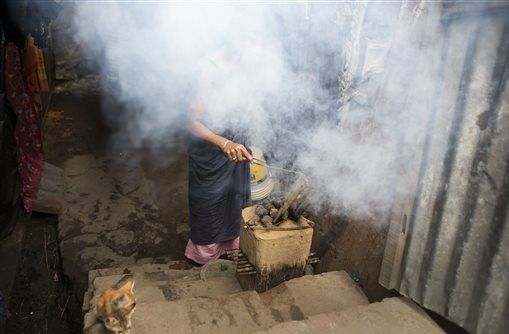Kitchen fumes, dangerous like tobacco
The type of oil used for cooking and the resulting air pollution it generates within the household would increase the chances of developing arthritis and osteoarthritis.

International study links cooking fuels to arthritis and osteoarthritis It found greater likelihood among those who cook with gas, kerosene, charcoal, wood, and farm or animal fuels. The research included participants from Mexico.
The type of fuel used for cooking and the resulting air pollution it generates within the household would condition an increased chance of developing arthritis and osteoarthritis.
This is suggested by research published in PlosOne and conducted in low- and middle-income countries in Asia, Africa, and Latin America, where the burden of this exposure is often high.
According to the researchers, permanent exposure to polluting smoke produced by most fuels used for cooking affects the body's ability to keep the natural process of oxidation of cells in balance (oxidative stress, associated with the development of diseases), and leads to decreased immune response. These effects occur in a similar way to those produced by tobacco smoke.
"The mechanism is not known, but it may be related to the aggravation or involvement of inflammatory and/or immune pathways," that is, the body's response to damage or trauma, Shelby Yamamoto, a researcher at the School of Public Health at the University of Alberta, Canada, and lead author of the study, told SciDev.Net.
The research was conducted in China, Ghana, India, Mexico, Russia, and South Africa using standardized questionnaires that asked participants to indicate the type of fuel used for cooking by giving them six options: electricity, gas, kerosene, coal, wood, and agricultural or animal fuels.
They were also asked to answer a series of questions related to previous diagnoses of arthritis or joint pain.
Except for electricity, all other forms of fuel are associated with a higher likelihood of arthritis (69 to 95 percent), with the use of agricultural and animal products posing the greatest risk.
For the authors, one explanation would be that collecting and transporting this type of fuel - which is usually collected from the ground - and involves sitting, kneeling, bending, or squatting, creates repetitive stress on the joints.
These positions are also repeated during the cooking process when using burners that burn biomass fuels. In contrast, the association between those who use gas as their primary cooking fuel and arthritis may be due to the mixed use of burners and/or fuel.
"We observed, for example, that participants from Mexico had the highest proportion of gas users and were much less likely to report arthritis. However, it is unknown whether this is due to a lower prevalence of arthritis, under-diagnosis, regional variations in reporting, or another reason," Yamamoto said.
Arthritis is an autoimmune disease that causes a patient's immune system to attack their joints, resulting in swelling, pain, and stiffness, and can be disabling.
There are up to 100 types of arthritis, according to the Arthritis Foundation of America, and the most common is rheumatoid arthritis (RA). It is estimated that 0.3 to 1 percent of the world's population suffers from it. Osteoarthritis is caused by mechanical wear and tear on the joints.
Although air pollution is generally associated with several chronic non-communicable conditions such as cardiovascular disease, chronic obstructive pulmonary disease, and lung cancer, previous studies have found smoke to be a major source of risk for the development of RA.
Thus, a study in New Mexico found a greater likelihood of developing rheumatic diseases and systemic lupus erythematosus among people exposed to volatile particles, reduced sulfur compounds, heavy metals, and household dust. Other studies1 show that there is an increased risk of arthritis among populations exposed to mineral dust, insecticides, and textiles.
However, there is currently no evidence of air pollution and osteoarthritis.
The study also looked at some demographic covariates of participants, such as level of education, body mass index, income level, type of housing, tobacco and alcohol consumption, and level of physical activity. In total, more than 30,000 people of both sexes and between the ages of 18 and 70 participated.
Women over 50, overweight, past or current alcohol users, and those with angina, diabetes, lung disease, depression, or hypertension would also be more likely to develop arthritis. Conversely, low weight and a higher level of education were associated with a lower risk of developing the disease.
For Laura Llambí, professor at the Faculty of Medicine of the University of the Republic of Uruguay, although this is an interesting study, its main weakness is that "it does not distinguish between rheumatoid arthritis and osteoarthritis".
"The occurrence or not of this condition was based on the subjects' response to a series of standardized questions and not on clinical diagnosis," she said.
"Given these studies, it is important to remember that, due to the methodological design of the research, the finding implies an association between two phenomena and not necessarily a linear causal link," she warns.
However, he clarifies that by proposing several explanations for the finding, "from biological pathways in which contaminants increase oxidative stress and modify the immune response (as tobacco does), to some more mechanical ones related to transportation, cargo, and body postures that involve people in procuring and cooking daily with fuels such as wood or charcoal," more research is needed, "since if these findings are replicated they could be a reason for large-scale prevention health policies.
The study authors warn that this is the first step, and more research is needed with biomarkers that measure air pollution in the home and the progression of various types of arthritis about exposure levels, among other things.
Source Scidev




